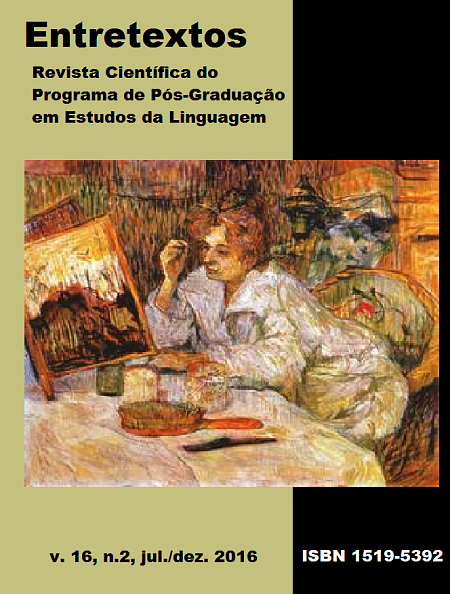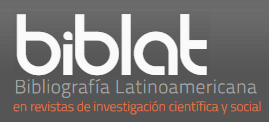The Structural metaphor of the tale Champavert, le lycanthrope (1833), by Pétrus Borel (1809-1859)
DOI:
https://doi.org/10.5433/1519-5392.2016v16n2p221Keywords:
Metaphor, Grotesque, Pétrus BorelAbstract
This study aims to analyse the enunciative scenography composition (MAINGUENEAU, 2006) of the Champavert, le lycanthrope (1833) tale, written by Petrus Borel, legitimate representative of the French Frenetic Romanticism. The central issue of this article is linked to the saturation of grotesque metaphors in this tale, in its relationship with the enunciative identity of the author. The metaphors that permeate through the Champavert, le lycanthrope tale refer to the grotesque subjects of metamorphosis and the opposition between being-seeming. These metaphors weave and direct the readability of the narrative (GENETTE, 1972, 1991), indicating the strategies in the composition of its enunciative scenography. The textual analysis process reveals the structural and structuring potential of the society's metaphor like a swamp, a "conductive analogue thread" (BORDAS, 2003) of the tale chosen.Downloads
References
BORDAS, Éric. Les chemins de la métaphore. Paris: PUF, 2003.
BOREL, Pétrus. Champavert: contos imorais. Trad. José Domingos Morais. Lisboa: Assírio & Alvim, 2006.
BOURGEOIS, René. Pétrus Borel. In: BOURGEOIS, René. L’ironie romantique. Grenoble: Presses Universitaires de Grenoble, 1974. p. 65-83.
CLARETIE, Jules. Pétrus Borel le lycanthrope. Sa vie, ses écrits, sa correspondance. Poésies et documents inédits. Paris: Pincebourde, 1865. Disponível em: http://gallica.bnf.fr/. Acesso em: 10 abr. 2006.
GAUTIER, Théophile. Les Grotesques. Paris: M. Levy, 1859.
GENETTE, Gérard. Métonymie chez Proust. In: GENETTE, Gérard. Figures III. Paris: Seuil, 1972. p. 41-63.
GENETTE, Gérard. Style et signification. In: GENETTE, Gérard. Fiction et diction. Paris: Seuil, 1991. p. 95-151.
HAMON, Philippe. Du descriptif. Paris: Hachette, 1991.
JOLIBERT, Bernard. La commedia dell’arte et son influence en France du XVIe au XVIIIe siècle. Paris: L’Harmattan, 1999.
KAYSER, Wolfgang. O grotesco. Trad. J. Guinsburg. São Paulo: Perspectiva, 2003.
LA FONTAINE, Jean. Le renard et les poules d’Inde. In: LA FONTAINE, Jean. Œuvres complètes. Fables, contes et nouvelles. Paris: Gallimard, Bibliothèque de la Pléiade, 1991. t. I.
LAKOFF, George; JOHNSON, Mark. Les métaphores dans la vie quotidienne. Trad. de Michel Fornel en collaboration avec Jean-Jacques Lecercle. Paris: Minuit, 1985.
LOUVEL, Liliane. Texte image. Images à lire, textes à voir. Rennes: Presses Universitaires de Rennes, 2002.
MAINGUENEAU, Dominique. Discurso literário. Trad. Adail Sobral. São Paulo: Contexto, 2006.
MORIER, Henri. Dictionnaire de poétique et de rhétorique. 4e éd. Paris: PUF, 1989.
NERVAL, Gérard. Profession de foi. In: NERVAL, Gérard. Œuvres complètes. Paris: Gallimard, “Bibliothèque de la Pléiade, 1989. t. I, p. 313.
RIFFATERRE, Michel. La métaphore filée dans la poésie surréaliste. Langue Française, Paris, v. 3, n. 1, p. 46-60, 1969. Disponível em: http://www.persee.fr/doc/lfr_0023-8368_1969_num. Acesso em: 10 jun. 2008.
Downloads
Published
How to Cite
Issue
Section
License
Entretextos adota a Licença Creative Commons Attribution 4.0 International, portanto, os direitos autorais relativos aos artigos publicados são do(s) autor (es).
Sob essa licença é possível: Compartilhar - copiar e redistribuir o material em qualquer suporte ou formato. Adaptar - remixar, transformar, e criar a partir do material, atribuindo o devido crédito e prover um link para a licença e indicar se mudanças foram feitas.




















